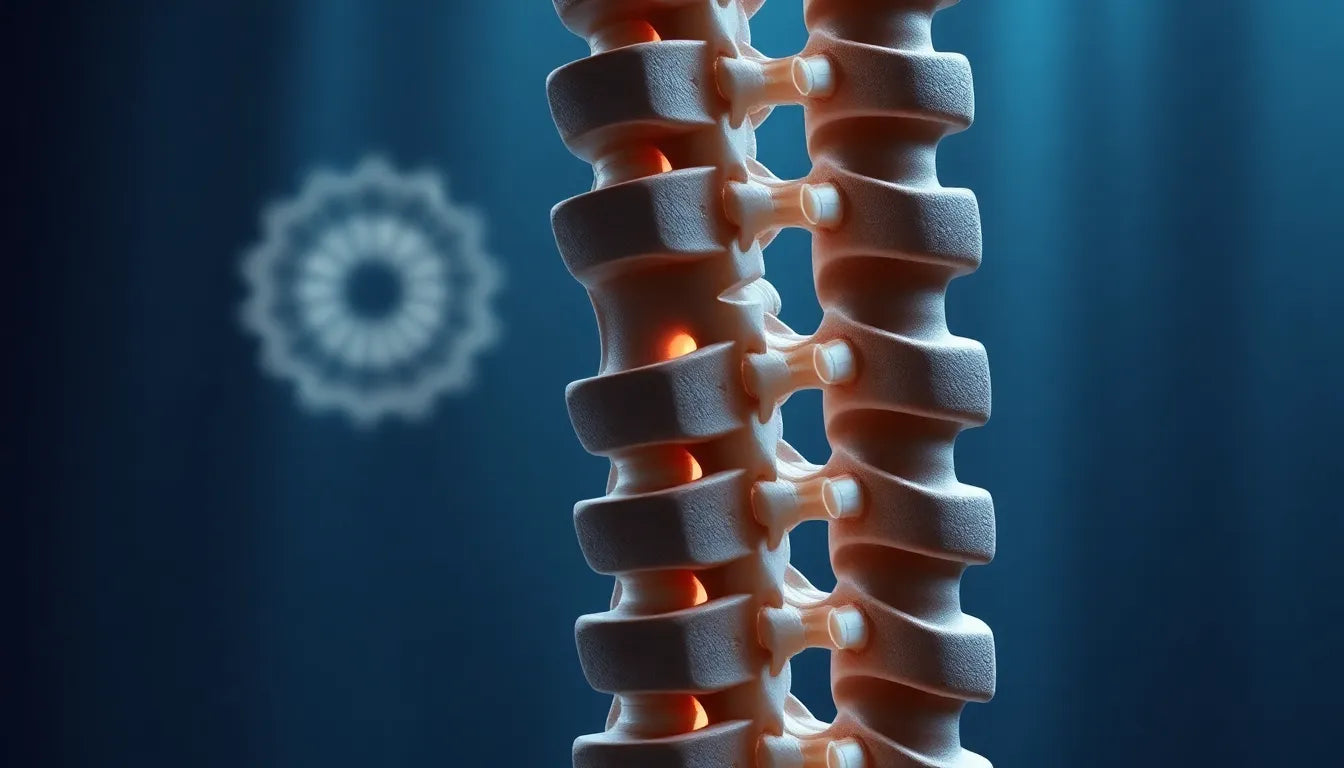Understanding how a herniated disc is repaired begins with grasping the basics of what a herniated disc truly is. Essentially, our spine is composed of a series of bones called vertebrae, cushioned by discs that act as shock absorbers. A herniated disc, often referred to as a slipped or ruptured disc, occurs when the soft inner gel of a disc pushes through a tear in its tougher exterior, potentially irritating nearby nerves. This condition can lead to symptoms such as pain, numbness, and weakness, typically affecting the lower back and legs or the neck and arms.
Herniated discs are quite prevalent, especially among individuals aged 30 to 50, and can significantly impact daily life. The discomfort and mobility issues they cause can interfere with everything from work to recreational activities, making it vital to understand the available repair options. Addressing these symptoms promptly and effectively is crucial for maintaining quality of life and preventing further complications.
The journey to relief: exploring treatment pathways
The journey to relief from a herniated disc often involves navigating a spectrum of treatment pathways, ranging from conservative management to surgical intervention. The primary goal is to alleviate pain and restore function while minimizing risks. For many, the initial approach involves non-surgical treatments, which can be highly effective in managing symptoms and promoting healing. These may include physical therapy, pain management strategies, and lifestyle modifications aimed at reducing strain on the spine.
However, when conservative measures fail to provide adequate relief or when the herniated disc leads to severe neurological symptoms, surgical options may be considered. It's important to note that the choice of treatment should be highly personalized, taking into account the specific needs and medical history of the individual. A tailored approach ensures that the selected pathway aligns with the patient's unique circumstances, maximizing the chances of a successful outcome.
As we delve deeper into the topic, we'll explore both non-surgical and surgical repair methods, shedding light on the latest advancements and techniques available. Understanding the full range of options empowers individuals to make informed decisions about their health and embark on the most suitable path to recovery.
non-surgical treatments for herniated discs
For many individuals experiencing the discomfort of a herniated disc, non-surgical treatments offer a first line of defense in managing symptoms and promoting healing. These conservative management strategies are often effective, especially when symptoms are not severe. Physical therapy is a cornerstone of non-surgical treatment, focusing on exercises and techniques designed to strengthen the muscles surrounding the spine and relieve pressure on the affected disc. This approach not only helps in pain reduction but also enhances flexibility and overall spinal health.
Pain management is another critical component, often involving medications such as non-steroidal anti-inflammatory drugs (NSAIDs) or corticosteroids to reduce inflammation and alleviate pain. In some cases, muscle relaxants may also be prescribed to ease muscle spasms associated with herniated discs. These medications can significantly improve comfort and mobility, allowing patients to engage more fully in physical therapy and daily activities.
In addition to these medical interventions, lifestyle adjustments play a vital role in managing herniated disc symptoms. Ergonomic aids, such as supportive chairs or mattresses, can help reduce strain on the spine, while activity modification and weight management are crucial in minimizing further stress on the affected area. By incorporating these changes, individuals can often achieve significant relief and prevent future occurrences.
The effectiveness of conservative management varies, with many individuals experiencing substantial improvement within weeks to months. However, if symptoms persist or worsen, exploring surgical options may become necessary.
minimally invasive surgical approaches
When conservative treatments do not provide sufficient relief, minimally invasive surgical procedures can offer an effective alternative for repairing a herniated disc. One of the most common and successful procedures is the microdiscectomy. This surgery involves the removal of a small portion of the herniated disc, specifically the material that is pressing on the nerve root, through a small incision. The minimally invasive nature of this procedure means that it typically results in less tissue damage, reduced pain, and a quicker recovery time compared to traditional surgeries.
Patients undergoing a microdiscectomy often experience rapid improvement in symptoms, with many able to return home the same day and resume light activities within one to two weeks. The procedure boasts high success rates, with most patients reporting significant pain relief and improved function.
Advancements in endoscopic techniques have further enhanced the minimally invasive options available. These techniques allow surgeons to access the herniated disc through even smaller incisions, reducing recovery time and minimizing the risk of complications. Endoscopic procedures are particularly beneficial for patients seeking the least invasive solution with the fastest return to normal activities.
traditional and other surgical procedures
In certain cases, more extensive surgical interventions may be necessary, particularly when there is significant spinal instability or when previous surgeries have not been successful. A lumbar laminectomy may be performed, which involves the removal of a portion of the bone overlying the spinal canal to relieve nerve pressure. This procedure is often considered when there is a need for greater access to the affected area or in the presence of conditions such as spinal stenosis.
Spinal fusion is another option, typically reserved for cases where the entire disc needs to be removed. This procedure involves fusing two or more vertebrae together to stabilize the spine. While effective, spinal fusion may limit flexibility and is generally considered when other treatments have failed.
Alternatively, artificial disc replacement offers a solution that preserves more spinal mobility compared to fusion. This procedure involves replacing the damaged disc with an artificial one, maintaining motion at the affected segment. It is an attractive option for select patients, offering the potential for pain relief while preserving spinal function.
Each of these surgical options carries its own set of risks and benefits, and the choice of procedure should be guided by a thorough evaluation of the patient's specific condition and overall health. Consulting with a healthcare professional is essential to determine the most appropriate surgical approach, ensuring the best possible outcome.
Comparative analysis of surgical options for herniated discs
When considering surgical options for repairing a herniated disc, it's essential to understand the differences between procedures such as microdiscectomy, lumbar laminectomy, and spinal fusion. Each of these methods varies in terms of invasiveness, recovery time, success rates, and potential risks.
| Procedure | Invasiveness | Recovery Time | Success Rates | Potential Risks |
|---|---|---|---|---|
| Microdiscectomy | Minimally invasive | 1-2 weeks for light activities | High | Infection, nerve damage, recurrence |
| Lumbar Laminectomy | Moderate | Several weeks | High for relieving pressure | Infection, nerve damage, spinal instability |
| Spinal Fusion | Invasive | Several months | Varies | Limited flexibility, infection, hardware failure |
Patient outcomes can vary significantly based on the chosen procedure and individual circumstances. For instance, a young athlete with a single-level disc herniation might benefit greatly from a microdiscectomy, while an older patient with degenerative spinal conditions might require a fusion for stability.
Real-life patient stories often highlight the importance of choosing the right surgical path. For example, Jane, a 45-year-old office worker, found relief from chronic back pain after a successful microdiscectomy, allowing her to return to her daily activities quickly. Meanwhile, Tom, a retired builder, opted for spinal fusion to address multiple herniated discs and now enjoys improved stability and reduced pain.
Conclusion: choosing the right path
Choosing the right path for herniated disc repair involves careful consideration of various factors, including the severity of symptoms, patient lifestyle, and overall health. Consulting with healthcare professionals is crucial to tailor treatment plans that align with individual needs and preferences.
Ultimately, the decision should be guided by a combination of medical advice and personal priorities, ensuring that the chosen treatment maximizes the chances of a successful recovery and return to normal activities.
Frequently asked questions
What are the risks associated with herniated disc surgery?
Herniated disc surgery, like any surgical procedure, carries potential risks, including infection, nerve damage, and the possibility of disc recurrence. It's important to discuss these risks with a healthcare provider to understand how they might apply to your specific situation.
How long is the recovery period after surgery?
The recovery period varies depending on the type of surgery. For minimally invasive procedures like microdiscectomy, patients often return to light activities within 1-2 weeks. More extensive surgeries, such as spinal fusion, may require several months for full recovery.
Can herniated discs heal without surgery?
Yes, many herniated discs can heal without surgery through conservative treatments such as physical therapy, pain management, and lifestyle modifications. These approaches are often effective for managing symptoms and promoting natural healing.
What lifestyle changes can aid in recovery and prevent recurrence?
Ergonomic improvements, regular exercise, and maintaining a healthy weight are key lifestyle changes that can aid in recovery and prevent recurrence of herniated discs. These adjustments help reduce strain on the spine and support overall spinal health.
When should surgery be considered for a herniated disc?
Surgery should be considered when conservative treatments fail to provide relief or when severe neurological symptoms, such as significant weakness or loss of bladder control, are present. A thorough evaluation by a healthcare professional can help determine if surgery is the appropriate course of action.
Sources
- Mayo Clinic. "Herniated Disc Surgery and Fusion Overview."
- Sciatica.com. "Stepwise Treatment Guide, Microdiscectomy Details."
- Cleveland Clinic. "Microdiscectomy Explained."
- Medical News Today. "Types of Surgeries, Minimally Invasive Focus."
- Spine-health. "Video and Article Explaining Treatments and Recovery."
- Spine-health. "Full Range: Conservative, Microdiscectomy, Fusion, Disc Replacement."
- Dr. Likover. "Clinical Services for Herniated Disc Surgery."


















